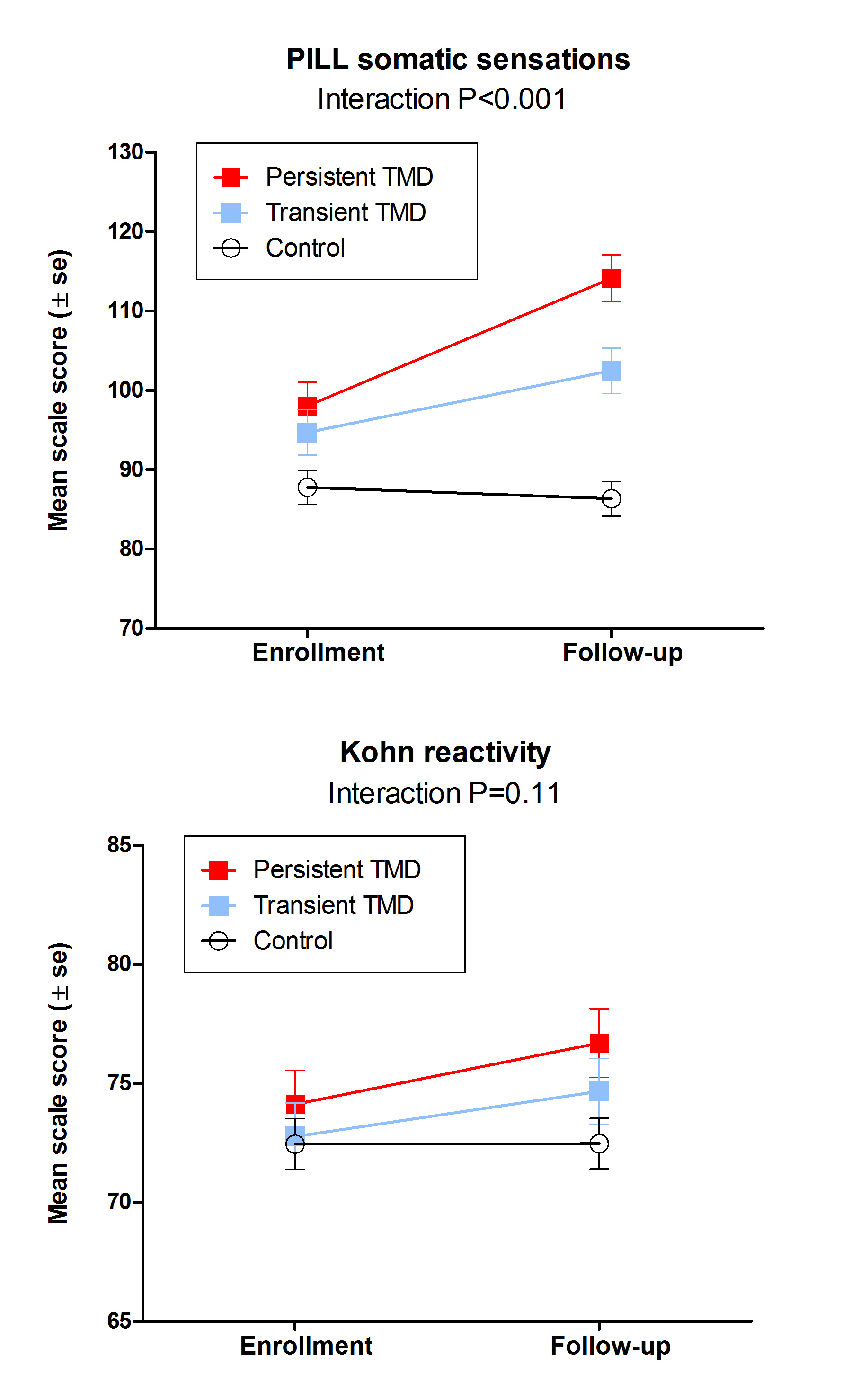IADR Abstract Archives
Somatic Sensations, Not Sensory Reactivity, Predict TMD Onset and Persistence
Objectives: Somatic sensations (e.g., chills, nausea) are thought to be amplified by hyper-reactivity to noxious stimuli (e.g., cold water, ocean voyage), thereby increasing risk of pain syndromes.
Objective: To determine contributions of somatic sensations and sensory reactivity to onset and persistence of painful TMD.
Methods: Nested case-control study of TMD incidence in the OPPERA study (Orofacial Pain: Prospective Evaluation and Risk Assessment). When enrolled at four U.S. study sites, n=3,258 adult volunteers had no history of TMD; during a median three-year observation period, n=260 developed first-onset TMD. Six months later, examinations identified three groups: n=71 “persistent” TMD cases who still had clinical TMD; n=75 “transient” TMD cases whose first-onset TMD had resolved; and n=126 sampled controls who were free of TMD throughout the study. The Pennebaker Inventory of Limbic Languidness (PILL) questionnaire measured somatic sensations at enrollment and six-months post-onset. The Kohn Reactivity Scale (KOHN) measured sensory reactivity. Linear mixed models for repeated measures used PILL and KOHN scores as dependent variables to ascertain variation according to case-status (persistent, transient, or control), visit (enrollment, follow-up) and their interaction.
Results: At enrollment, PILL and KOHN scores were not correlated (r=0.17). Relative to controls, PILL scores at enrollment were significantly greater in subjects who later developed persistent TMD (P=0.005) and were marginally greater in those who developed transient TMD (P=0.051). After enrollment, PILL scores at follow-up increased significantly for both persistent (P=<0.001) and transient (P=0.004) cases, although not for controls (P=0.47). KOHN scores did not differ significantly between groups at enrollment and did not change significantly during follow-up.
Conclusions: The pattern for PILL is consistent with state-like, somatic sensory experiences that predicted who developed persistent TMD and that increased after TMD onset. Lack of change in KOHN scores suggests a trait of sensory reactivity which, counter-intuitively, did not predict risk of developing TMD.
Objective: To determine contributions of somatic sensations and sensory reactivity to onset and persistence of painful TMD.
Methods: Nested case-control study of TMD incidence in the OPPERA study (Orofacial Pain: Prospective Evaluation and Risk Assessment). When enrolled at four U.S. study sites, n=3,258 adult volunteers had no history of TMD; during a median three-year observation period, n=260 developed first-onset TMD. Six months later, examinations identified three groups: n=71 “persistent” TMD cases who still had clinical TMD; n=75 “transient” TMD cases whose first-onset TMD had resolved; and n=126 sampled controls who were free of TMD throughout the study. The Pennebaker Inventory of Limbic Languidness (PILL) questionnaire measured somatic sensations at enrollment and six-months post-onset. The Kohn Reactivity Scale (KOHN) measured sensory reactivity. Linear mixed models for repeated measures used PILL and KOHN scores as dependent variables to ascertain variation according to case-status (persistent, transient, or control), visit (enrollment, follow-up) and their interaction.
Results: At enrollment, PILL and KOHN scores were not correlated (r=0.17). Relative to controls, PILL scores at enrollment were significantly greater in subjects who later developed persistent TMD (P=0.005) and were marginally greater in those who developed transient TMD (P=0.051). After enrollment, PILL scores at follow-up increased significantly for both persistent (P=<0.001) and transient (P=0.004) cases, although not for controls (P=0.47). KOHN scores did not differ significantly between groups at enrollment and did not change significantly during follow-up.
Conclusions: The pattern for PILL is consistent with state-like, somatic sensory experiences that predicted who developed persistent TMD and that increased after TMD onset. Lack of change in KOHN scores suggests a trait of sensory reactivity which, counter-intuitively, did not predict risk of developing TMD.

